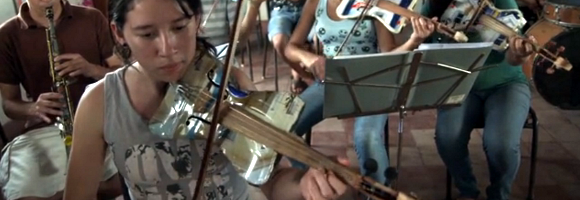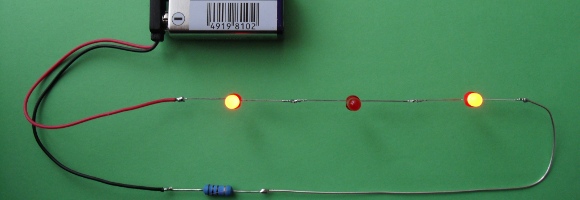Cardboard box computer

[Alistair] chapman had a Laptop with a broken screen sitting in his parts bin. He knew he had an LCD panel on hand that would probably work with it, but it wouldn’t fit in the case. His solution was to transplant all the computer parts into a cardboard box from a motherboard.
This violin is garbage

The kids in this orchestra live in a villiage built on top of a landfill. But they make the most out of what they have. This orchestra is composed of instruments built from garbage and they seem to work pretty well. [Thanks Bruce]
More LED mystery puzzles

[Henryk] is at it again. He puts together some very impressive circuits that play tricks on your engineering mind. His latest is three LEDs in series. Look closely and you’ll see they’re not performing as expected. Watching the solution to one of his previous puzzles will help you figure out how he’s doing it. His work is simply amazing.
Netbook framed as a dedicated weather station

Not wanting to get rid of old but still working hardware, [Retro Toaster] built a dedicated weather station by mounting the screen, keyboard, and track pad in a picture frame.
Current and voltage testing your USB projects

This dev board is a pass-through for USB devices. It makes voltage and current testing your device quite simple.
















I was really impressed with the LED one…until I saw the solution to the other and saw he did with an MCU…then I watched more of the video and became even more impressed than I originally was.
I wonder why there is a jumper between the LED and the resistor, rather than just soldering the two together…a clue perhaps?
LOL @ the three LED magic trick. You have to question what’s in the resistor along with everything else.
Magic: 100 hours of work for 60 seconds of amazing.
If you look at how the USB standard is designed you will see that, because of voltage drop in connectors and cables, there are devices that accept only one cable. If you try to use more, or the device here, they will fail because of the voltage drop. When you add an extra cable and an extra pair of connectors and the multimeter wire resistance and the ampermeter resistance some devices will not work.
I’ve seen this problem on a few webcams and hard discs: even with a 15cm extension they will not start. True, your device will be suitable for some measurements, but not all.
The correct way to build this would be to have an external power supply that allows for current measurement but stabilizes the voltage at the pins of the host connector, to guarantee the voltage is within specs there.
Thin cables drop voltage to high current devices? Who knew?
I probably don’t have a single device not plugged via an extension cable and they range from webcams and audio interfaces to programmers and FPGA boards. What planet you’re from?
I can tell you that copying data from a SD card isn’t affected by the USB Tester. Getting same speeds even connected with a unpowered USB hub.
I’m not into it’d not ha/it’s a ck thing. But the musical instruments probably fulfills what a good number pf persons would call a hack& not a thing to it at all. I expected that the cello was going to sound like full load on a manure spreader, but it wasn’t bad at all to my ears
Can you translate this sentence:
I’m not into it’d not ha/it’s a ck thing.
I think I figured it out!
I’m not into “It’s not a hack” / “It’s a hack” thing.
$12USD (plus shipping) for the USB tester – Bwhahahahahaha
So is it made of Idontthinksotanium?
Economy of Scale,
If they were to produce 100K of them, the price should drop, but I doubt if there are 100K USB hackers/wannabees out there.
Ren is right. I am just starting out. If I am able to produce in high quantities then I will be able to drop the price. Right now the PCB’s aren’t cheap.
More worrying on the USB passthrough, look at how the data lines are routed.
If any high speed device works with this thing inline it’s due to sheer luck.
How you would improve it? I am open to suggestions. I haven’t had any problems yet. I mostly use it with serial communications.
I did some reading up on that and it looks like I should be okay. I setup my ground plain on the same layer as the data lines and used 10mils trace width. Looks like I could improve it with a ground plain on the bottom as well since I have bottom traces that are data lines.
Correction: Ground plane.
Amazing how good that cello sounds, considering it’s made from trash. The other instruments too. I would say it sounds acceptable for a beginners instrument even by our standards.
Yeah. The woodwinds are…a little off, but the cello sounds more like it’s from an old recording than like it’s made from trash (it helps that he plays one of my favorite cello pieces).
I don’t play my cello anymore, but I got a hell of a lot out of being in the school orchestra. It makes me happy that kids can get that same experience even if they don’t have access to or just can’t afford “real” instruments.
This reminds me of the Jack White special everyone was building a few years back.